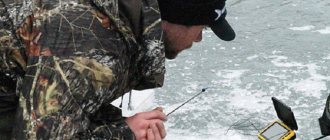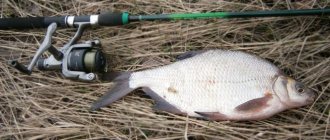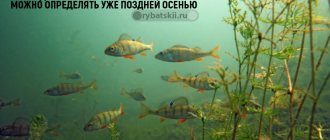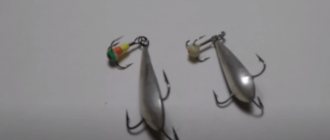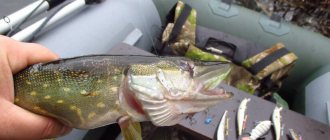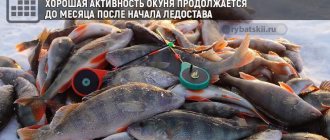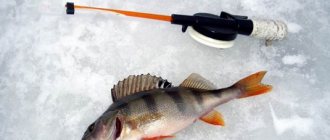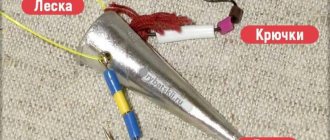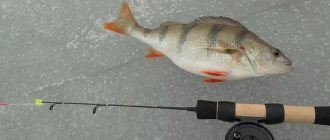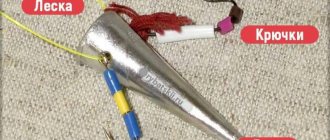Features of winter fishing for perch
Firstly, we want to say right away that perch is not the kind of fish that needs to be guarded while sitting near one hole. Of course, sometimes you get lucky, and from the first drilled hole you come across a school of perch. But this is like pointing a finger at the sky.
Our article is not intended to encourage you to go fishing for perch, hoping for luck. And relying on knowledge and the ability to apply this knowledge.
As you already understand, the basis of winter perch fishing is its constant search. He constantly moves around the pond, and the saying “Legs feed the wolf” is right about him.
Anyone who has ever caught an active perch in winter knows how cool it is, how much drive and adrenaline it gives. When the perch is active, it takes sharply and greedily, almost everything that you offer it.
But the passive perch, of course, needs to be stirred up:
First, pick up the bait;
Secondly, select the wiring;
Thirdly, you can play with the diameter of the fishing line, for example, instead of 0.14, put 0.12.
In any case, it is important to understand that winter fishing for perch involves dozens of holes drilled and kilometers of distance traveled on ice.
How to lure perch
When luring and searching for perch, you can use bait; in winter, it is usually live bloodworms. You need to throw it in small bunches into each hole and wait 10-15 minutes; if there is a perch nearby, it will do. But in shallow water, in this way you can also lure the annoying ruffe, which will ruin the whole fishing, so you need to be careful with bait.
The following artificial baits are used for perch fishing:
Popular artificial baits for perch in winter
- Jigs;
- Winter perch spoons;
- Silicone fish and worms with jig heads.
- Flies tied to jigs.
Perch loves everything noisy and shiny, so your bait should shine, use gold or silver colors. The main fishing tactic is to slowly or quickly lower the bait to the bottom and tap it on the bottom; if a fish is nearby, it will definitely become interested and attract the whole school.
As soon as the flock approaches, you can periodically throw small bunches of bloodworms at it to provoke it and create a competitive process.
A bunch of bloodworms works best as a bait for a jig; sometimes maggots are effective.
Gear Tips:
- Take several fishing rods with different fishing line diameters when fishing. If the bite is inactive, reduce its diameter. For a very bad bite, throw one fishing rod with a fishing line diameter of 0.08 mm into the box; sometimes the bite can only be on this one.
- Use fluorocarbon line.
- Always carry spare fishing rods, as frequent breaks are possible, and retying the tackle in the cold is not convenient and is a waste of time.
Where to look for perch? Are there any perch here?
Finding perch in winter is the most important task for a winter fisherman. And if for some reason the perch does not bite, then the first thought that arises in the fisherman’s head is: “Are there any perch here at all?”
Getting the perch to bite is the second task that the fisherman faces. The main thing is to find it, which in fact, in some cases is not so easy.
The curiosity and aggression of the perch forces it to take even such bait that does not correspond to its food base. It's all about the ability to provoke the perch to attack.
Many fishermen are of the opinion that all movements of perch in a body of water are random and chaotic. We fundamentally disagree with this. Like any living creature, perch has its favorite places where it likes to feed or just stand.
And also, his favorite paths along which he likes to move around the pond. We agree that he has many favorite places. And they change depending on the time of year, weather, and the topography of the reservoir itself.
Where to look for perch on the first ice, in the dead of winter, and on the last ice?
First ice;
Deaf winter;
The last ice.
But still, these periods have a general trend, and it’s worth sticking to it.
Perch fishing in overgrown areas
Date: December 9, 2015 | 530
Perch tends to move around the reservoir, ending up in a variety of places. One of the popular places visited by schools of perch are shallows, small areas, often heavily overgrown with algae. And since the object of our spinning hunt often appears there, then we need to know how to catch perch in the thickets . You can catch perch in and near aquatic vegetation with different baits. But, as usual, we will talk about catching perch with soft baits and edibles.
Shallow water areas are found in almost all types of reservoirs where we go to catch perch with a spinning rod. There are shallow places on ponds, on lakes, in reservoirs and large rivers there are extensive shallow bays and riffles.
In spring the shallows are not yet overgrown. And you can catch perches there at this time with a regular light jig or microjig. Small baits are used: twisters, vibrotails, worms, slugs measuring 2-2.5", if the perch is large - up to 3". Since there is no current in such places or it is very weak, and the depths do not exceed 1.5-2 m, the lightest weights (from 1g to 3-4g, rarely more) and delicate installations are used. The bait is attached to a light jig head or a swivel mount and is passed along the bottom in a jumping motion, with pauses. If there is a lot of last year’s unrotted algae at the bottom and the hooks are getting stuck, then you can try to move the bait in the thicker water, preventing it from falling to the bottom. Active spring perch before spawning, and some time after it, can be caught very well using various baits and baits. This is a blessed time, no complaints.
But as the water warms and summer approaches, many of the shallows become overgrown. The perch goes to deeper and cleaner places. But, it regularly comes out to feed in overgrown areas. So, an angler who wants to catch perch needs to visit such overgrown places throughout late spring, summer, and autumn.
However, compared to early spring and late autumn, conditions become difficult. Dense, or not very dense, aquatic vegetation does not allow you to normally cast and carry out classic jig baits... Constant hooks, scared fish and zero results.
When the question arises about catching perch with a spinning rod in overgrown places, you first need to assess the type of aquatic vegetation and the density of the thickets. It depends on this whether there is a chance to fish normally in such places, and if there is a chance, then what baits and equipment to use.
Aquatic vegetation can be varied. These could be fields of water lilies rising from the bottom, under the water lilies it could be clear, or there could also be a layer of elodea (in common parlance - nettle), there could just be thickets of nettles and pondweed. The sandbank may be overgrown with rushweed or other similar plants.
If the vegetation is dense , then all that remains is to catch perch on its edge, where it turns into clear water, in the windows between the vegetation, or above the carpet of vegetation if it does not reach the surface.
To fish edges, windows or the surface layer above the grass, it is best to use small vibrating tails or twisters, i.e. active silicone baits mounted on a hinge or on a small jig head. The size of the bait in such conditions ranges from 1” to 2.5”, rarely up to 3”. The fisherman uses a light spinning rod, a microjig version. To fish the upper layers of water and prevent the bait from falling into the thicket of algae and getting caught, the lightest weights are used, 1-3g, no more. So, the test of the spinning rod must also correspond.
We cast, don’t let the bait fall into the grass, and immediately start retrieving at medium or fast speed so that the twister or vibrotail passes in the upper layer. If the window is deep among the grass, then you can give a pause, making some kind of stepwise wiring in the water column. You can also lightly twitch the bait, bringing the rig closer to you not by directly rotating the reel, but by light or sharp jerks and pulls. And the reel only picks up the slack.
If the vegetation is relatively sparse , for example, a school of perch hunts in a field of water lilies. Here it is better to use a different tactic. Of course, you can fish the edges of water lilies, rare windows among them. But, it will be more effective to fish directly in an area with vegetation. Here, in order not to cling to each wiring, you need to make a non-clinging installation on an offset hook. We attach a silicone worm, slug, crayfish to the offset machine and tie the hook directly to the fishing line or leash of the spinning rod, i.e. We don’t use a sinker. Lures are used in sizes 2-3”. There is no point in cutting it too much, but it is not wise to use edible food under 4”, purely for perch. Only if the hunt is for seasoned humpback whales, which are not such frequent guests in overgrown shallow water...
Of course, the dead weight of such a bait may not be enough. And there are two ways to build up enough weight to cast tolerably. You can use special offset presses with a small weight placed directly on the bend. You can load the offset machine yourself by clamping a shot, a strip of lead, or winding several turns of thin wire solder. The second approach is to use edible food, which has its own considerable weight. This is typical for soft baits saturated with salts. The specific gravity of such silicone is higher than that of water and such bait slowly sinks under its own weight. And also, this weight of several grams is enough for casting without an additional sinker. So, the fisherman must follow one of these paths.
The bait is simply thrown into a field of water lilies. She slowly drowns, moving her tail or other limbs. The fisherman sets the bait in motion, leads with pulsating wiring, waves, and twitches. Such a bait, placed under a carpet of water lilies, perfectly attracts perches that hunt there, and also lures out insidious toothed pikes.
So, despite the apparent difficulty of the conditions, it is often possible to fish the most overgrown places using soft baits, edibles and catch perch from the very thickets.
Share with your friends:
Categories: Edible fishing · Tags: Algae, Installation, Perch, Shoal, Offset hook
Winter migration of perch across the pond
In winter, the movements of perch can be divided into: large migration and daily migration. Throughout the winter, perch often changes its favorite stopping and feeding places, sometimes covering considerable distances. (This is called the great migration). Also, during the course of the day, perch can change its location many times.
This depends on several factors:
Oxygen saturation at a point;
Availability of natural food;
Weather.
This is what is called the daily fish migration. TIP : if you see snags sticking out of the water, be sure to fish this place!
Migration and settlement of perch on the first ice
According to the first ice, the places for catching perch are practically no different from summer ones. The most promising places at this time of year are coastal areas. Even at a depth of 0.5 meters, you can catch a trophy perch quite well, not to mention the standard of 200-300 grams.
What to look for when choosing a location:
In close proximity to the shore;
Snags sticking out of the water, bushes, frozen, fallen trees, etc.;
Driftwood at the bottom, grass;
Steps and depth differences, no more than 0.5-1 meters, any bottom irregularities.
At this time of year, perch is most active and aggressive, constantly prowling in such places.
TIP : Don't spend more than 10 minutes on a hole. If within 10 minutes you are unable to catch a spot, move on to the next one. And so on until you come across a flock. If you find a perch, but you feel that it is somehow hesitant, weak, sluggish.
First thing you need:
Change the wiring technique (change the game with bait);
Reduce the weight of the bait (or increase, depending on the situation);
Think about the diameter of the fishing line. This also greatly affects the perch’s interest in your equipment.
Don't neglect old holes. For example, in the morning you were successfully fishing in one place, then the bite suddenly stopped, and you went to another place, it stopped in another place, you went to a third.
During all this time, the perch could very well return to your first place. Or vice versa, if the place is very promising, both visually and in terms of bottom topography, but the perch didn’t bite at all. It is advisable to check such a place a little later.
Tackle and fishing tactics
To hunt for perch in winter, you should prepare gear for winter fishing.
The most popular are:
- Tackle with jig.
- Fishing rods with spinners and balancers.
- Zherlitsy.
With the help of a fishing rod with a jig, which produces the necessary action, you can achieve a good bite. Many fishermen catch perch using a jig without a nozzle. The jig is attached to the fishing line at the desired angle. When using a nozzle, the jig should be mounted in a vertical position.
A jig that moves in leaps and bounds can attract fish. It is necessary to ensure that there are no deviations from the vertical. The bait should not glide or move smoothly. In this case, the predator will not react to it.
It is necessary to pull it, lifting it slightly up from the bottom level. You can place the jig on the bottom and then move it a little. If the bottom is covered with silt, the water will begin to become cloudy, which will attract the attention of the fish.
In winter, the lure must be held vertically, unlike summer fishing. This reduces the likelihood of catching aquatic vegetation hidden under the ice crust.
Because If fishing is carried out through a punched hole, it is necessary to avoid strong deviation of the spoon from the middle of the hole. It is necessary to select a spoon depending on the type of reservoir. If it is shallow, then light weight baits will be most suitable. If there is an underwater current, preference should be given to a weighted bait.
A balancer is a spoon that is shaped like a fish. It can move up and down, or it can be fixed in one position. It is attached to the tackle horizontally. There is a hook on the belly of such a balancer. To increase efficiency, treble hooks are used.
To attract fish, the balancer must move. Balancers come in a variety of colors and sizes. Often fishermen make homemade balancers for catching perch in winter.
The winter girder is slightly different from the standard one, which is used when fishing for pike.
Based on the size of the striped predator, it is necessary to use light equipment. It is more sensitive and less noticeable.
You should adhere to the necessary tactics during winter fishing:
- An important point is to choose a place with a suitable bottom topography.
- After a place has been found, you should punch several holes and feed them.
- After this, you need to make 8-12 holes, the distance between which should be from 4 to 6 m. They need to be fed.
- Then you should return to the first hole and start fishing, moving alternately from one hole to another.
If the oxygen level in the water decreases, the fish become less active. You need to know how to catch passive perch. For this purpose, you will need a bait that will make slow movements and stop from time to time.
Do you need bait?
If the fish bites weakly, then you need to feed it. To do this, they use feeders that sink to the bottom, where they open. Thus, a mound of food is formed at the bottom, near which the fish gather. This increases the bite many times over.
In some cases, this slide becomes food for the ruff, which can pay attention to it faster than the perch. To avoid this, you need to sprinkle it with sand.
It is best to place such slides near a school of fish. Then a large perch (which can be seen less frequently in winter) will be the first to notice the food and will not allow the ruffe to approach it. Thus, the chances of catching a huge perch in winter increase significantly.
During the cold season, the fish are actively looking for food, so there is a high probability that it will bite even without complementary food. But there are also times when you can’t do without it.
Where do perch hiccup in the middle of nowhere?
In January and February, the tactics of searching for perch change dramatically, as do its habitats. In the dead of winter, perch, like any other fish, is passive.
It moves little, is found in deep places, with snags, grass, stones or any irregularities at the bottom. If at any other time, perch can be lured by playing bait from a distance of tens of meters, then in the middle of winter such a trick will not work.
The search radius for perch in the wilderness is greatly reduced; holes are drilled from each other at a distance of no more than 2 meters. In a word, the bait must be placed right under the perch’s nose, only then can you count on results.
In addition, when you find a perch, it would be useful to feed it. Basically, a feed bloodworm or jig is used for this. Important: complementary foods of animal origin.
How to find perch in shallow water
In order to minimize the time spent on this activity, you need to move through shallow water areas and fish ready-made holes. In principle, any tackle will do, the main thing is not very rough. The main task of the gear is to search for fish and find it, and not to constantly fish in one place. In the future, the tackle is changed to a more convenient and suitable one.
In shallow water, water conditions are variable, so fish in such areas are most sensitive to external factors. If there is no vegetation in the reservoir near the shore, then the holes should be made as deep as possible, at a distance of 5-15 meters from each other, it all depends on the size of the reservoir and the presence of other anglers. At shallow depths, fishing should begin in the morning or during the daytime, because The perch moves closer to the shore just at this time. In the twilight, on the contrary, it is not worth catching a perch, because time will be spent searching for it, and as a result, there is a very high chance of missing the perch bite. Also, the fisherman will be sure that there will definitely not be a bite where he just was.
If the weather changes and the bite worsens, you should also measure the depth. A series of holes drilled in the ice perpendicular to the shore can help determine where the perch may swim. In this case, you can determine where the largest concentration of fish is (usually it goes to where there is a clear drop into depth). If there is no difference in depth, do not despair; perch usually stays closer to the shore during the daytime. The best bottom for perch is a rocky, muddy bottom that is practically of no interest to it. But if the bottom with silt is overgrown with grass, there may be more fish there than on a rocky bottom.
There are several clues where the fish might be. Firstly, this is the presence of grass and vegetation. It attracts perch because there is enough oxygen there. Secondly, a clearly defined line with algae means a sharp change in depth in this place. In algae with gaps, sparsely located, the best bite is at the beginning and end of the winter fishing period. In the middle of winter, when there is not enough oxygen in the water, a bite may appear in the reed thickets, but it is not advisable to wade into it. In addition, there is a high chance of the gear being torn off in the reed thickets, and this does not bring pleasure to any fisherman. It is best to drill a series of holes perpendicular to the shore where there is less grass or on the border with it and at 15-20 meters in depth. After finding the fish “horizon”, you need to make holes with periodic shifts in depth and towards the shore, leaning on the perpendicular.
Read! Coloring maggots at home
Where to look for perch on the last ice?
The tactics for finding perch at the end of winter are practically no different from the first ice. As the ice melts, you should look for perch closer and closer to the shore. He is gradually returning to his usual habitats.
Every day the water becomes more and more saturated with oxygen, thereby increasing the activity of the perch. This means that the radius of drilling holes increases 10 times, and finding perch becomes many times easier than in the middle of winter.
Where to look for perch on small rivers and lakes?
It is much easier to find perch on small rivers than in large reservoirs and rivers.
First of all, you should orientate along the shore and coastal zones. All landmarks and signs of promising locations for perch are exactly the same as described above. Namely:
Driftwood. Both at the bottom and sticking out of the water. Fallen trees frozen in ice, bushes;
Any bottom irregularities. Depth differences from 0.5 to 1 meter, no more;
Steep banks, steep slopes, and so on.
The search for perch on small rivers begins from the very shore, starting with fishing at the coastal edges, gradually moving away towards the river bed. As for lakes and ponds, here the search for perch is carried out according to the same principle.
The same fish, the same favorite habitats. The only thing that may differ from river perch fishing is: the type, weight and color of the bait. In such places, the bait should be selected as closely as possible to the natural food of the perch.
Where to look for a predator?
In winter, look for perch at a depth of 2-4 m in places with an uneven bottom surface, as well as with the presence of snags and reeds. The search for food occurs directly at the bottom. From February to March, the fish rise closer to the surface.
To achieve a large catch, it is necessary to probe not only a large water area, but also the depths of the reservoir. Perch prefers to hunt for food by gathering in schools. If a frenzied perch bite is detected in a reservoir in one place, and after a while it stops biting, then you should change the place of fishing. Fishermen often travel up to 10 km in 1 day, looking for places with a good bite.
Small rivers and lakes
There are places where fish are found in large quantities. These are channels with a quiet current, located between the shore and island ledges, as well as deep-water places located under the branches of bushes that are frozen into the edge of the ice. In such places, during warming, you can find ide and roach.
Not far from such places, there is a fast water flow along the edge. On small rivers and lakes, this fish looks for prey in places with large accumulations of algae. In these places, it can be lured closer to the surface of the water using spinners, poppers and surface wobblers.
On grassy lakes, perch can be found along the entire water area of the reservoir, but in an unfamiliar reservoir you need to look in places where there are steep slopes.
Large bodies of water
In large rivers and lakes, finding perch becomes more difficult. It can live in various places throughout the aquatic area. It is most rarely found in river beds at a depth of more than 4 m. In these places, only the humpback whale can be found. Most often, the flow in such rivers is slow.
You can find perch on the river at depths from 2 to 4 m. You can try to track the location of the school, guided by splashes of water.
Experienced fishermen look for perch in places where asp are found. These fish are most often found nearby, only perch prefers deep-sea places with calm currents. It is not easy to catch an asp, because... It is characterized by cautious behavior, but by its location it is easy to determine the presence of a school of perch in the immediate vicinity.
In river bays, this fish is found in places overgrown with reeds, water lilies, and near the edges. It is best to search at a depth of 2 to 3 m. It can live in sandy shallow water (mainly in the warm season).
This fish is found in large lakes and reservoirs close to the coastline:
- sandy;
- clay;
- peat;
- granite quarries.
In such reservoirs, the bottom depth can reach 20 m or more, so you should “hunt” for this fish along the coastal edge with vegetation.
Where to look for perch on large rivers and reservoirs?
Finding perch in such a huge water area is not easy. And if the reservoir is completely unfamiliar, then one might even say it’s unrealistic. You should go to such reservoirs prepared for perch. Prepared in the sense of at least theoretically having an idea of the river’s topography, the presence of dumps and edges.
It certainly wouldn’t hurt to ask local fishermen to find out what’s going on. Moreover, now all this is freely available: thematic forums, groups on social networks.
Of course, you can always find your way on ice even without special knowledge of the reservoir. It is enough just to stay close to the bulk of the fishermen. If you see a bunch of anglers, you can be sure there are fish there, or at least there were.
Just wandering around a pond and drilling holes anywhere is dooming yourself to failure in advance. The main thing is to find a slope, edge or ridge. And then it’s a matter of technique; we begin to drill in a checkerboard pattern in search of perch.
It’s better, of course, to go fishing with a group of people, as many actually do. This way, finding a perch is much faster and easier than alone.
The influence of weather on the behavior of perch
The bite and activity of perch can be influenced not only by the periods of winter: first ice, deep winter, last ice, but also by the weather. Let's take a closer look at how weather affects perch activity. When is it worth going fishing for perch, and when not?
In general, the best time for fishing has always been considered when the weather has been the same for a long time, without sudden changes in atmospheric pressure and temperature.
But what to do when the weather is constantly changing, calm gives way to wind, atmospheric pressure fluctuates: sometimes low, sometimes high, air temperature sometimes plus, sometimes minus?
What should you pay attention to when planning a fishing trip?
Full moon. It has been noticed more than once that when the moon is full, the bite is simply disgusting;
The predator is most active at low atmospheric pressure, and passive at high;
During the thaw the bite is always good. But you probably already know this very well;
The best air temperature for catching perch in winter is up to -15°C. When the thermometer drops below -15°C, catching perch will be more difficult.
No one has been able to prove with certainty that this is indeed the case. They seem to be experienced fishermen, they all say the right thing, but everyone is different. Of course, you should focus on the weather, but not always and not everywhere. For each body of water and its inhabitants, changes in weather and pressure act in their own way.
Tactics for searching for active perch
Constant search and fishing of all promising places is what awaits every angler hunting for perch. When a promising location is found, 10 holes are drilled at once, at a distance of approximately 15 meters.
The holes need to be drilled in a checkerboard pattern. After we have drilled 10 holes, we begin to fish them, spending no more than 10 minutes per hole.
We would also like to point out that when searching for active perch, the distance between holes should be 10-15 meters. Since active perch can be lured by playing bait from longer distances.
If the search begins from the coastal zone, then in the absence of a bite, they begin to shift towards the river bed. Also drilling holes in a checkerboard pattern, and at a distance of 10-15 meters.
If you finally find a perch, but for some reason it doesn’t take it, but simply pokes at the bait. This is already good, since we completed the first task facing us - we found a perch.
Then we simply select the desired bait, balancer, jig or spinner.
And if the bite starts, we fish until it stops. When the bite stops, we move on again to the first task - finding the perch. Moreover, periodically returning to their old holes, therefore, as practice shows, in most cases they work.
To fish holes, a balancer is most often used. It attracts perch from as far away as possible. And when the perch approaches, we act according to the situation depending on the bite. If there is no bite or frequent, idle bites, we change the bait to a lighter one.
Winter fishing for perch in deep places
On the first ice, perch, as a rule, stays at a sufficient depth, if the reservoir allows it, for example, on deep lakes or in areas of retaining dams on reservoirs, so you have to catch perch from the depths.
When fishing like this, there is no point in using light lures. Since the first reason for this is that such lures are hardly noticeable in limited visibility, and therefore are not very attractive. And the second reason for this is that light spinners have significantly less vibration power than heavy spinners, so the fish may not be interested in them at all. It is necessary to use heavy spoons so that the mass is at least 7-10 grams.
As for playing with heavy spinners, there are also some nuances here. Firstly, the pause after the fall of the spinner should be increased.
Even though a larger mass spinner will glide faster and worse, its vibrations will also decay much more slowly due to its own inertia. To achieve planning of the spoon as far as possible from the hole, the swing of the rod should reach a height of 1-1.5 meters. For this purpose, rods up to 1 meter long will be optimal. When fishing for perch at great depths, one should not forget that fish can feed not only at the very bottom, but also above.
At such times, the rate at which the spoon is fed is also important! It is recommended not to take long enough pauses while fishing. If there is no spinner - the object of attack, even for at least 1-1.5 minutes, the fish considers this as a loss of food, a movement of a school of fry, so it immediately swims away in search of it in other places .
As practice shows, in such cases, single-hook vertical spoons will be the most effective, since the removal of such a spoon from the mouth of the catch will be minimal. And if the bite is very active, you can even use spinners with a hook without a barb.
While searching for perch at different depths, you can try holes with both a change of spoon and a change of game. The point is that the choice of bait weight directly depends on the depth of the place; the deeper, the heavier the bait should be in order to absorb water resistance. But when using the same spoon at depth, you need to increase the pause, for example, from three to seven to ten seconds.
Tactics for searching for passive perch
The tactics for searching for passive perch are very different from the tactics for searching for active perch. Although the basic principles are the same, there are still a few nuances.
The fact is that a passive perch moves little and mostly stands in one place. And it will no longer be possible to lure him with bait from a distance of 10-15 meters.
Although the principle of drilling holes is the same, we make the distance between holes no more than 2 meters. As soon as you present the bait under the perch’s nose, you can count on a bite.
